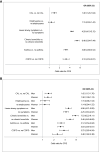Chronic Airflow Limitation, Lower Respiratory Symptoms, COPD and Chronic Rhinosinusitis in a Middle-Aged Population: The Swedish CArdioPulmonary bioImage Study (SCAPIS). A Link Between the Lower and Upper Airways
- PMID: 39959845
- PMCID: PMC11829582
- DOI: 10.2147/COPD.S493219
Chronic Airflow Limitation, Lower Respiratory Symptoms, COPD and Chronic Rhinosinusitis in a Middle-Aged Population: The Swedish CArdioPulmonary bioImage Study (SCAPIS). A Link Between the Lower and Upper Airways
Abstract
Purpose: Chronic rhinosinusitis (CRS) is related to asthma and chronic obstructive pulmonary disease (COPD). However, combined data on CRS, pulmonary function, lower airway symptoms, and cigarette smoking from the general population are lacking. The current study investigates the relationships between CRS and chronic airflow limitation (CAL), lower airway symptoms and COPD in a middle-aged population of ever-smokers and never-smokers.
Patients and methods: All subjects from the Swedish CArdioPulmonary bioImage Study (SCAPIS) were included. Subjects underwent spirometry after bronchodilation. Chronic airflow limitation was defined as FEV1/FVC ratio <0.7. Computed tomography imaging of the thorax was performed to detect the presence of emphysema, and the subjects answered a comprehensive questionnaire on CRS, lower airway symptoms, asthma, chronic bronchitis, and cigarette smoking habits.
Results: In total, 30,154 adult subjects in the age range of 50-64 years were included. The prevalence of CRS was 5.6%. CRS was more-prevalent among subjects in the following categories: CAL (7.6%), lower airway symptoms (15.7%), current smokers (8.2%), asthma (13.6%), never-smokers and ever-smokers with COPD (17.6% and 15.3%, respectively), emphysema (6.7%), and chronic bronchitis (24.5%). In the adjusted regression model, CRS was significantly associated with CAL (OR 1.40), lower airway symptoms (OR 4.59), chronic bronchitis (OR 6.48), asthma (OR 3.08), and COPD (OR 3.10).
Conclusion: In this national, randomly chosen population sample of more than 30,000 middle-aged men and women, CRS is associated with CAL, lower airway symptoms, chronic bronchitis, asthma, and COPD. In patients with CRS and in patients with lower airway inflammation, it is important to consider the inflammatory status of the entire airway system.
Keywords: CRS; asthma; chronic bronchitis; chronic obstructive pulmonary disease; emphysema; smoking.
© 2025 Andersson et al.
Conflict of interest statement
Dr Anders Andersson reports personal fees from Astra-Zeneca, Chiesi, and TEVA, outside the submitted work. Dr Apostolos Bossios reports grants paid to institution from AstraZeneca, Chiesi, and GSK, outside the submitted work; and Head of Assembly 5 (Airway diseases, asthma, COPD, and chronic cough), European Respiratory Society; co-chair of the Nordic severe asthma network; member of the steering committee of SHARP, ERS severe asthma Clinical Research Collaboration; member of the steering committee of the Swedish National Airway Register. Professor Magnus Sköld reports grants from Pharmaceutical companies paid to his institution for consultancy, outside the submitted work. The authors declare that they have no other competing interests in this work.
Figures




References
Publication types
MeSH terms
LinkOut - more resources
Full Text Sources
Medical

